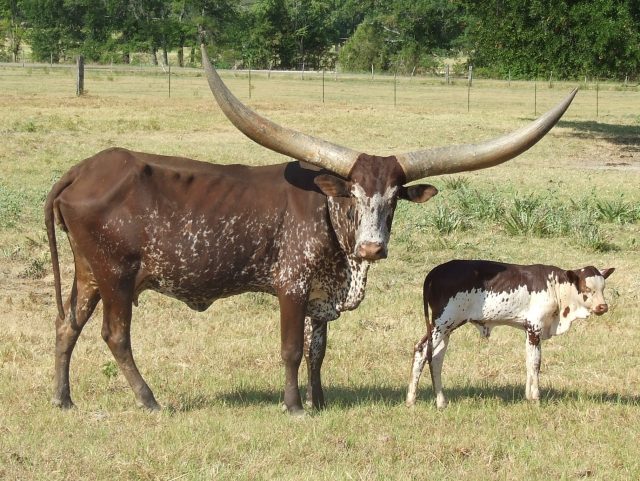Type the name of the breed you're looking for below
[wpdreams_ajaxsearchlite] Don't see the breed your're looking for? Click here and let us know!
Ankole-Watusi cattle
| Place of Origin | Africa |
| Origin | Long-horned, humpless domestic cattle were well established in the Nile Valley by 4000 B.C. These cattle, known as the Egyptian or Hamitic Longhorn, appear in pictographs in Egyptian pyramids. Over the next twenty centuries (2.000 years), the Egyptian Longhorn migrated with its owners from the Nile to Ethiopia, and then down to the southern reaches of Africa. By 2000 B. C., humped cattle (Longhorn Zebu) from Pakistan and India reached Africa. When these Zebu reached the region now known as Ethiopia and Somalia, they were interbred with the Egyptian Longhorn. The admixture produced -- the Sanga -- spread to the Sudan, Uganda, Kenya, and other parts of eastern Africa, becoming the base stock of many of the indigenous African breeds. The Sanga demonstrated most of the typical Zebu characteristics, such as pendulous dewlap and sheath, upturned horns, and a neck hump of variable size. Modern descendants of the Sanga, however, vary greatly in size, conformation, and horns, due to differing selection pressures by different tribes. Particularly remarkable are the cattle found in Uganda, Rwanda, and Burundi. In Uganda, the Nkole tribe's Sanga variety is known as the Ankole. In Rwanda and Burundi, the Tutsi tribe's Sanga variety is called the Watusi. The Rwanda common strain of Watusi is called Inkuku. The giant-horned strain, owned by the Tutsi kings and chiefs, is called the Inyambo, though some current tribal reports claim that this type is now extinct. Traditionally, Ankole-Watusi were considered sacred. They supplied milk to the owners, but were only rarely used for meat production, since an owner's wealth was counted in live animals. Under traditional management, the Ankole cow was grazed all day, then brought home to her young calf. The calf was allowed to suckle briefly to stimulate milk letdown, then the cow was milked by the herdsman. The calf suckled after hand-milking was finished and was again separated from its mother. The process was repeated in the morning. This minimal nourishment of calves resulted in high death rates in the young. Milk production was not high, with a typical cow producing only 2 pints of milk daily, although an exceptional one could manage up to 8 pints. In addition, the lactation period was short. Over the last 10 years, the national government has attempted to select for animals which produce more milk and have better meat production. Famine and disease, as well as the conflict with traditional practices, have slowed this effort. |
| Purpose | Meat, Dairy and Draught (work) |
| Appearance | The Ankole-Watusi is medium in size. |
| Horns | In Rwanda, where the Tutsi ruled, Watusi were known as Insanga, "the ones which were found" and Inyambo, "the cows with long, long horns". Those with the largest and longest horns belonged to the king and were considered sacred, with some individuals having horns that measure 12 feet (3.7 m) from tip to tip, are used for defense and cooling by blood vesseled honeycombs |
| Cows Average Weight | 430 – 540 kg (950 - 1200 lbs) |
| Bulls Average Weight | 540 – 730 kg (1200 - 1600 lbs) |
| Other Considerations | Ankoles are able to utilize poor quality forage and limited quantities of food and water. These survival abilities have allowed them as a breed to not only survive the centuries in Africa but to become established in Europe, South America, Australia, and North America. Two Ankole-Watusi individuals are in the Guinness World Records for the largest horn circumferences for a bull and steer, respectively. The bull, named CT Woodie, had horns which measured 40.75 inches (103.5 cm) around on September 20, 2004. The steer, named Lurch, had horns measuring 37.5 inches (95 cm) around on May 6, 2003; he died on May 22, 2010. |



